Pedro and Me
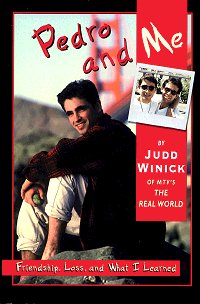 Anybody who’s listened to me for any length of time about How I Read Comics (and the corollary topic of How Comics Should Be Published) knows that I don’t like stories to be serialised, because I’d rather sit down for an hour (or a few, if I’m lucky and get something really meaty) and read the whole thing in one sitting. I developed this preference from the experience of immersing myself in an deep poignant novel like Stuck Rubber Baby or an enthralling adventure like JLA: The Nail. I get a lot more out of a story that way than 22 pages per month, so please give it to me all at once.
Anybody who’s listened to me for any length of time about How I Read Comics (and the corollary topic of How Comics Should Be Published) knows that I don’t like stories to be serialised, because I’d rather sit down for an hour (or a few, if I’m lucky and get something really meaty) and read the whole thing in one sitting. I developed this preference from the experience of immersing myself in an deep poignant novel like Stuck Rubber Baby or an enthralling adventure like JLA: The Nail. I get a lot more out of a story that way than 22 pages per month, so please give it to me all at once.
Judd Winick released Pedro and Me that way, but ironically that’s not how I read it. Instead, I nibbled at it, a few pages at a time. I’d read an anecdote, then put it down. The next day I’d open it up, read a little, and set it aside. That’s because I didn’t feel I could handle it all at once. After all, I knew how it ended, and I knew I’d have trouble with it. In case someone picked the book up without knowing, Winick “spoils” it right on page 2, so we all know what to expect. Pedro dies.
The book is a memoir of the friendship between the author and Pedro Zamora, the roommate he met on the trend-setting voyeuristic drama series The Real World on MTV in 1994. I never watched the show (I don’t have cable), but I knew who Pedro Zamora was anyway through my involvement in gay youth services and AIDS activism, and had even heard him speak before the rest of the world met him through the show.
That may sound like hipper-than-thou bragging, but my point is that the self-assured, handsome 20-year-old had made quite an impression on me. He was doing exactly what I had once promised myself to do if I ever got AIDS. And much the same thing my uncle Jim did when he became ill: going out fighting to make a difference. I was a Pedro Zamora fan, even without seeing him on TV. And combined with my experiences losing people I cared about to AIDS (and other things), dredging that all up with a 180-page reading session was more than I was prepared for.
So I nibbled. Always stopping before I got caught up in it.
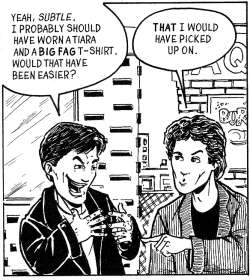 But what I wasn’t prepared for was last night, when the book just kind of grabbed me and kept me reading. I finished a few pages and kept going. On one hand, I wasn’t looking forward to the ending. But on the other… the book was funny! I hadn’t expected that.
But what I wasn’t prepared for was last night, when the book just kind of grabbed me and kept me reading. I finished a few pages and kept going. On one hand, I wasn’t looking forward to the ending. But on the other… the book was funny! I hadn’t expected that.
This isn’t just some Hollywood, movie-of-the-week weepfest. It’s a first-person account of a friendship between two people in doubly unusual circumstances: the fishbowl in which they lived, and the daunting challenges one of them faced (and ultimately they both did, each in their own role). Winick includes anecdotes that illustrate the growth of their friendship, good times and bad. He uses examples like the awkwardness of Pedro coming out to his new roommate, leading to the friendly - sometimes teasing - banter of two young friends. Which provides some stark contrast to the more somber moments, which - as happens in real life - often intermingle. Winick also provides thoughtful insights into what’s happening, even revealing his own shortcomings.
This unusual openness is only surprising until you consider that the author is someone who previously spent several months of his life in front of a national television audience, exposing himself much as Zamora had already done when he came out as gay and HIV+ and began speaking as an AIDS educator. If Winick had inhibitions about letting down his guard and sharing his life with the world, he’d already overcome them.
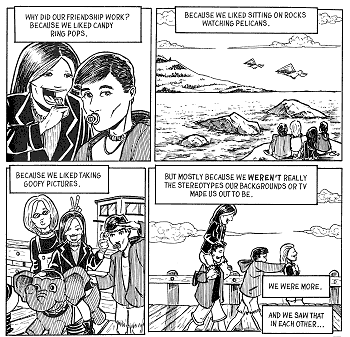 But those aren’t the only barriers Winick shows he’s lowered. What comes through clearly throughout the book is the affection he had for his friend, and the love they shared. Who knew straight men could be so deep? {grin} The concurrent development of Winick’s romance with housemate Pam Ling establishes where his hormones and romantic feelings lay, but you don’t get the impression that this is included to clarify what his feelings for Pedro were. Winick says “I love him” without apology or explanation; what he means is obvious, and he lets it stand as such.
But those aren’t the only barriers Winick shows he’s lowered. What comes through clearly throughout the book is the affection he had for his friend, and the love they shared. Who knew straight men could be so deep? {grin} The concurrent development of Winick’s romance with housemate Pam Ling establishes where his hormones and romantic feelings lay, but you don’t get the impression that this is included to clarify what his feelings for Pedro were. Winick says “I love him” without apology or explanation; what he means is obvious, and he lets it stand as such.
Another factor that helps the intimacy of this book is the medium. “The Real World”s directness came from the lack of scripting, but it was still filtered through the camera crews who chose when, where, and how to tape events, and had some restrictions on their access, through the show producers who condensed the footage into episodes, etc. The book is more direct: from the subject to the page to the reader. There’s some third-party material in the section about Zamora’s childhood, but by scripting, illustrating,and editing his own story, Winick gets to us without the middlemen.
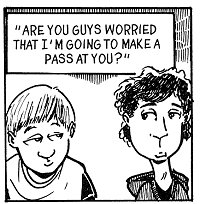 Some people might question whether Winick has the right “chops” to handle such serious - and real - material. His published writing to date has been mostly short joke strips and a recent series of comedic short stories. And his usual art style is cartoony, closer to Calvin & Hobbes than to Rex Morgan. But it’s also closer to Doonesbury than to Flash Gordon. That is, realism doesn’t correlate to “serious”, nor caricature to “lightweight”. Nonetheless, Winick leans toward the realistic end of his style here, and his ability to enhance the humour through exaggeration makes the somber scenes more so. His facial expressions are often subtle, but they’re unmistakable when he lets loose with them. A more consistent approach might have made for unified, real feel to the world he describes, but it’s not a serious shortcoming.
Some people might question whether Winick has the right “chops” to handle such serious - and real - material. His published writing to date has been mostly short joke strips and a recent series of comedic short stories. And his usual art style is cartoony, closer to Calvin & Hobbes than to Rex Morgan. But it’s also closer to Doonesbury than to Flash Gordon. That is, realism doesn’t correlate to “serious”, nor caricature to “lightweight”. Nonetheless, Winick leans toward the realistic end of his style here, and his ability to enhance the humour through exaggeration makes the somber scenes more so. His facial expressions are often subtle, but they’re unmistakable when he lets loose with them. A more consistent approach might have made for unified, real feel to the world he describes, but it’s not a serious shortcoming.
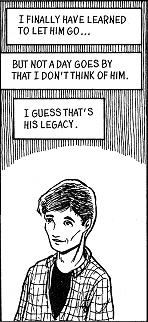 As for the storytelling, like so much autobiographical material, it’s a little awkward. There’s a sequence of events, but it’s not a real plot (because life is like that), so the scenes come off more as a series of vignettes than a novel. Characters are introduced then never appear again (such as a few of the other housemates). The passage of time is sometimes unclear. Sections are inserted seemingly because Winick wanted to include them somewhere. This is how I could pick it up and read bits at random, which was nice, but it made for a less well-paced story, even when I re-read it straight through. Much like I imagine the TV show was. Whether this was a conscious choice to match the storytelling to the Real-World format much of the book’s audience was used to, or was just the easiest way of dealing with the real-world material, I don’t know. But I guess I’d rather have a straight but occasionally choppy telling of significant scenes and events than a “based on a true story” dramatisation that follows all the rules of writing fiction.
As for the storytelling, like so much autobiographical material, it’s a little awkward. There’s a sequence of events, but it’s not a real plot (because life is like that), so the scenes come off more as a series of vignettes than a novel. Characters are introduced then never appear again (such as a few of the other housemates). The passage of time is sometimes unclear. Sections are inserted seemingly because Winick wanted to include them somewhere. This is how I could pick it up and read bits at random, which was nice, but it made for a less well-paced story, even when I re-read it straight through. Much like I imagine the TV show was. Whether this was a conscious choice to match the storytelling to the Real-World format much of the book’s audience was used to, or was just the easiest way of dealing with the real-world material, I don’t know. But I guess I’d rather have a straight but occasionally choppy telling of significant scenes and events than a “based on a true story” dramatisation that follows all the rules of writing fiction.
For the scripting, Winick couldn’t just fall back on the Real World material; even with cameras following them around for parts of it, there’s no way he could remember all the dialog verbatim. But he captures the spirit of real dialog pretty well; it feels “right”, like conversations I’ve had with good friends. And his narration manages to be non-intrusive most of the time.
I don’t blame anyone who might hesitate to pick up a book like this. It’s not exactly a “feel good” book, and it’s practically the antithesis of escapist fantasy that so many of us enjoy in comics. But I think it’d be an immensely rewarding read for anyone who has yet to endure the kind of friendship gained and then lost as Winick experienced. And for anyone who has… well, suffice it to say that I’ve thought of little else in the 24 hours since reading it.
